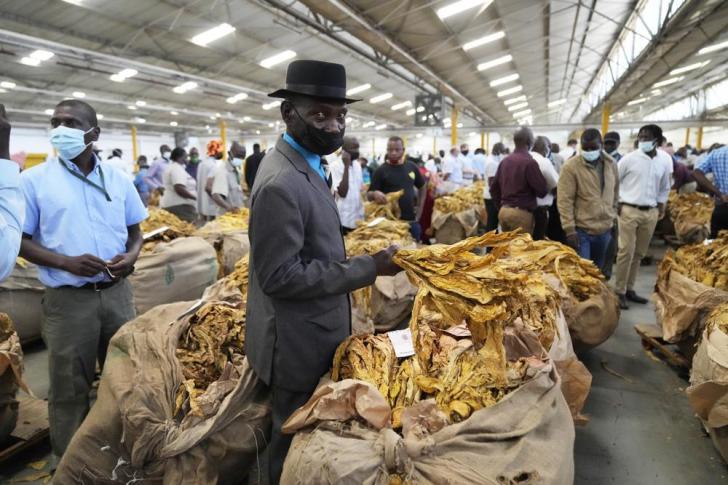News / Agriculture
Tobacco farmers urged to implement good agricultural practices (GAP)
30 Jul 2023 at 16:36hrs |
163 Views

Senior Agronomist Lazarus Gatawa has urged Tobacco farmers, in special reference to small scale growers who rely on rain fed to use good agricultural practices in order to enhance their productivity.
In the background of the record breaking tobacco volume produced in Zimbabwe during the 2023 marketing season where over 290 million kg were produced, more farmers will be attracted to venture into tobacco production. This will strengthen the need for farmers to produce high leaf quality in order to unlock more value and fetch good average prices of above $3 per kg. Going into the 2023-2024 farming season, there are prospects for a high supply of tobacco in the market thereby raising the demand for high quality leaf than just quantity.
This now entails farmers to elevate their efforts and do all tobacco production cycle activities to the required minimum standards. Farmers should rotate their tobacco with other crops like maize and ground nuts. Inline with the Plant pests and diseases Act ( Chapter 19:08), tobacco stalks are supposed to be uprooted and destroyed by 15th of May to avoid the spread of pests and diseases like anthracnose and Angular leaf spot. Land and seedbed preparation need to be achieved to the best practice and timing.
It is recommended that farmers complete sowing by mid August for the dry land tobacco. Early sowing will ensure that seedlings have ample time for the standard 2 week hardening period before the onset of the unpredictable climate change driven rainfall. It is better to have over-hardened seedlings than to have less hardened seedlings.
Well selected healthy and robust seedlings for transplanting are a prerequisite for a good crop stand. Farmers must only use certified seed and recommended agro-chemicals for better yield and quality.
It is advisable to plan to grow a hectarage that you have full inputs on and to use the correct plant population. The hectares that a farmer can grow should be positively related to the barn capacity and efficiency.
According to the Statutory instrument 116 of 2012 and the Forestry Act (Chapter 19:05), tobacco farmers are obliged to plant at least 0.35 hectares of Eucalyptus woodlot for every hectare of tobacco planted every year to create a wood curing energy alternative. This will also reduce pressure on indigenous trees like Brachystegia boehmii (Itshabela/Mupfuti), Julbernadia globiflora (Umshonkwe/Munhondo) and this ensures a sustainable tobacco production in Zimbabwe.
Farmers are encouraged to seek for advice from their local agricultural extension officers and Leaftechs who work for tobacco contractors based in the tobacco growing areas.
In the background of the record breaking tobacco volume produced in Zimbabwe during the 2023 marketing season where over 290 million kg were produced, more farmers will be attracted to venture into tobacco production. This will strengthen the need for farmers to produce high leaf quality in order to unlock more value and fetch good average prices of above $3 per kg. Going into the 2023-2024 farming season, there are prospects for a high supply of tobacco in the market thereby raising the demand for high quality leaf than just quantity.
This now entails farmers to elevate their efforts and do all tobacco production cycle activities to the required minimum standards. Farmers should rotate their tobacco with other crops like maize and ground nuts. Inline with the Plant pests and diseases Act ( Chapter 19:08), tobacco stalks are supposed to be uprooted and destroyed by 15th of May to avoid the spread of pests and diseases like anthracnose and Angular leaf spot. Land and seedbed preparation need to be achieved to the best practice and timing.
Well selected healthy and robust seedlings for transplanting are a prerequisite for a good crop stand. Farmers must only use certified seed and recommended agro-chemicals for better yield and quality.
It is advisable to plan to grow a hectarage that you have full inputs on and to use the correct plant population. The hectares that a farmer can grow should be positively related to the barn capacity and efficiency.
According to the Statutory instrument 116 of 2012 and the Forestry Act (Chapter 19:05), tobacco farmers are obliged to plant at least 0.35 hectares of Eucalyptus woodlot for every hectare of tobacco planted every year to create a wood curing energy alternative. This will also reduce pressure on indigenous trees like Brachystegia boehmii (Itshabela/Mupfuti), Julbernadia globiflora (Umshonkwe/Munhondo) and this ensures a sustainable tobacco production in Zimbabwe.
Farmers are encouraged to seek for advice from their local agricultural extension officers and Leaftechs who work for tobacco contractors based in the tobacco growing areas.
Source - Byo24News
Join the discussion
Loading comments…



